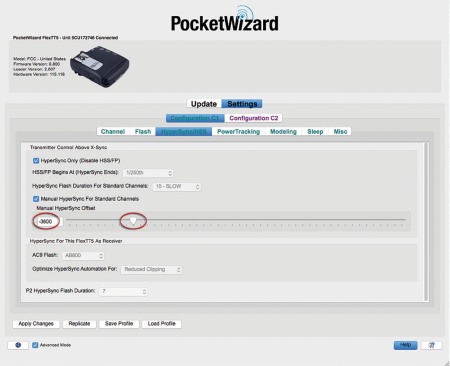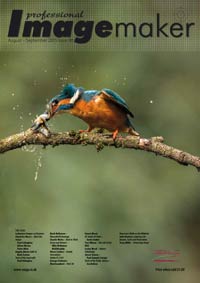articles/Lighting/light-part38-page2
Creating With Light - Part 38 - Hypersync 2 - part 2 of 1 2 3
by Dave Montizambert Published 01/08/2015

2
HyperSync Test
How do you HyperSync a shutter? First you must have a PocketWizard Flex TT5 Transceiver or Mini TT1 Transmitter to attach to your camera's hot-shoe to act as a transmitter. Then you need a second PocketWizard to act as a receiver plugged into the strobe; this unit doesn't have to be a Flex TT5 or a Mini TT1, I used the PocketWizard Plus III. But before you even try it out, you need to shoot a couple of tests: the first to determine the best offset (electronic instructions for flash to start before shutter opens) to program into the Flex TT5 or Mini TT1 - I used the Flex TT5 - and the second to calculate exposure. To find the optimum HyperSync offset setting, I assembled a Paul C. Buff X3200 WhiteLightning mono-block strobe (which is 1320Ws and has a flash duration of 1/300th of a second at full power) to evenly illuminate a white piece of paper while being positioned off the glare-angle to the paper. I then methodically experimented with the offset settings, see Image 002, starting at the lowest negative value -4500, then working my way up towards its highest 200, I made exposures with the various offset settings with my camera set to 1/8000th of a second.

3
For each new exposure, the camera shutter-speed and the strobe stayed locked to the same settings. For each new exposure of the test, my Flex TT5 was reprogrammed to the next whole value. I repeated this test until I found the image-file that had the least amount of dark vignetting, see Image 003, from the top down (landscape orientation) while not having any clipping of the image. I repeated this whole procedure for 1/4000th, 1/2000th, 1/1000th and 1/500th of a second. The optimum offset value for each was recorded. For example, shooting at 1/8000th of a second I got the best results at an offset setting of -3600. That was a fair bit of work, and even more so because I did it for my Paul C. Buff X2400 and my X1600 strobes too. They worked just as well for HyperSync as the X3200, however, the more powerful X3200 is a better choice when shooting at the higher shutter speeds such as 1/8000th of a second because of my observed 6-stop light loss.
Now that was just the first test so don't run off to try it out just yet, there is still another test to do - a guide-value test of sorts to figure out exposure because conventional light metering won't work correctly with HyperSync'ed strobe-light. That test will be the subject of my next installment of Creating With Light.
Please Note:
There is more than one page for this Article.
You are currently on page 2
- Creating With Light - Part 38 - Hypersync 2 page 1
- Creating With Light - Part 38 - Hypersync 2 page 2
- Creating With Light - Part 38 - Hypersync 2 page 3
1st Published 01/08/2015
last update 09/12/2022 14:55:58
More Lighting Articles
There are 0 days to get ready for The Society of Photographers Convention and Trade Show at The Novotel London West, Hammersmith ...
which starts on Wednesday 15th January 2025





